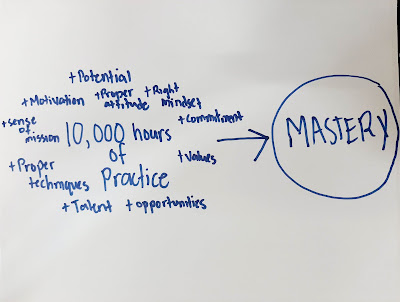Different careers require different forms of training. There are careers that require the development of our minds such as in Law, Literature, or Mathematics. There are those that require the enhancement of our physical attributes like Sports or Dance. There are also works that rely on our communication skills like Marketing or Journalism.
Given these, could there be a single principle that we can follow to effectively achieve mastery no matter what field we are in? A concise method that can straighten our path towards proficiency?
By knowing and studying masters-persons who have achieved success in their respective fields-there emerge an observable trend in their path towards competency. We come to know that technique, intensity of training, and passion are not all it takes to become great. There is a rather simple yet powerful factor that we often overlook: the amount of time we spend doing our craft.
Studies show that repository of experience throughout years of consistent practice has tremendous influence in achieving success on every profession. More over, researchers have agreed on a definite number of hours it take to become great: 10, 000 hours.
The 10,000 hour rule
The 10, 000 hour rule originated in a research conducted by K. Anders Ericsson, a Swedish psychologist focusing on human expertise and performance. However, it was not until Malcolm Gladwell referenced the rule in his book Outliers (2008) that it gained popularity.
The rule is basically what it is denoting: a person needs to spend at least 10,000 hours in a field or activity to achieve mastery, which can be surmised as a minimum of 5 hours of practice, 5 days a week for 10 years.
The case was true, in both Ericsson's and Gladwell's observation of successful people in history. Citing Mozart and The Beatles in his book, Gladwell posited that, starting at 8 years of age, Mozart did not produce the best of his works until he was aged 20, well over 2 years after completing his 10,000 hours at the age of 18. In The Beatles' case, their path towards 10,000 hours started when they played shows from 1960 to 1964 in Hamburg, Germany for over 1,200 times, spending 8 hours per night thereby arriving to 10,000 hours in just 4 years. Their first success came in 1964, and we all know that the rest is history.
 |
| Ericson's research at the Music Academy of West Berlin showing violinists' differences in aptitudes according to practice hours. |
The process
The straight approach towards incorporating the rule in practice is to keep track of one's practice time. The average year it takes to accomplish 10,000 hours is 10 years but it will vary according to pace. There are examples like The Beatles' where they were able to get to 10,000 hours in just 4 years. Pace will also vary depending on the nature of a career or a field. It would be easy to practice for several hours if the activity involves physical repetition like in sports (weight lifting, track and field, or swimming) but it would require a different approach when it comes to creative tasks such as writing, filmmaking or painting because these fields require more intellection and flexibility. I myself can write for several hours but it won't really help develop my writing if I would just do it mechanically. Creative tasks require just that, creativity, and it is something that requires inspiration, pauses, and idea generation. Nevertheless, 10,000 hours of experience remains the general rule of thumb.
This is why the rule gets much skepticism among academic circles.
Other factors to consider
In hindsight, the 10, 000 hour rule may seem like a shortcut to mastery but unfortunately it is not. Although the rule is backed up by real life examples and is considered generally true, pure practice alone won't get one to mastery. It is rather a mixture of potential, proper techniques, mindset, values, and opportunities coupled by deliberate practice that gets one there. This is where the rule can assert itself, and it is also where it can be the most effective. Once a person's values, motivation, potentials, and techniques are properly internalized, only then can the 10,000 hour rule yield merits. Only then it will seem like a straight road towards mastery.
* * *
There are still studies being conducted that serves to prove or disprove the 10,000 hour rule. But it remains a helpful principle to follow in aiming for mastery. What I like about the rule is that it is simple-it cuts to the core of complexity and points toward what really matters: the direct doing of our craft. Whatever our chosen field is, this will remain true. We can have all the ideas, the knowledge, and opportunities but if we don't translate them to action, mastery will remain elusive for us.
(P.S. I spent 5 hours writing this post.)
References:
Articles:
https://thefortisacademy.com/the-10000-hour-rule-2/
https://www.clubstreetpost.com/2018/03/the-10000-hour-rule-and-what-you-should-know-about-it/
https://www.newyorker.com/sports/sporting-scene/complexity-and-the-ten-thousand-hour-rule
https://readiscovery.com/2014/09/03/the-beatles-and-malcolm-gladwells-1000-hour-rule/
https://jamesclear.com/deliberate-practice-strategy
https://www.parentcorticalmass.com/2011/08/what-is-the-10000-hour-rule.html
Book:
Outliers (2008), by Malcolm Gladwell
Videos:
https://www.youtube.com/watch?v=EcMKLwVlpJk
https://www.youtube.com/watch?v=Dikz1B2Q2ks



Comments
Post a Comment